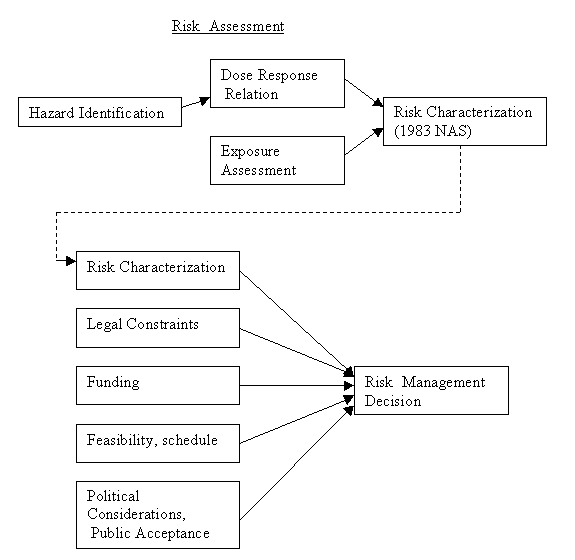
The early 1970's saw an enormous increase in health risk related laws and regulations. The Occupational Safety and Health Act and the creation of the Environmental Protection Agency for two. By the late 1970's congress realized that there were many federal agencies evaluating risk, and that they were often using very different standards. Congress commissioned the National Academy of Science (NAS) to study the issue and develop a strategy for evaluating risks. In 1983 the NAS produced Risk Assessment in the Federal Government: Managing the Process. The NAS proposed that the risk process be divided into two phases. The first phase, the Risk Assessment should be separated, completely if possible, from the second phase, Risk Management. The risk assessment would result in a statement of the probability and severity of the harm. Then the risk management phase would decide what, if anything, would be done about the risk. Risk assessment would be a scientific process, unsullied by money and politics. Risk management would start with this scientific input, then consider cost, benefits, politics, and many practical considerations. Here is diagram of the two phases.

We will spend most of our time on risk assessment, but for now you need to know the kinds of things that should be in each of the phases: Risk Assessment and Risk Management. Now's not the time for complexities, but how will you get funding for your risk assessment, if funding is part of the risk management phase?
Let's expand each of the four steps in the risk assessment (from the 1983 NAS)
Hazard Identification: ...determine whether exposure to an agent can cause an adverse health effect...characterizing the nature and strength of the effect.
Dose-Response Assessment:...characterizing the relation between the dose of an agent and the incidence of an adverse health effect.
Exposure Assessment:...estimating the current and future intensity, frequency, and duration of human exposure to an agent.
Risk characterization:...estimating the incidence of a health effect under conditions described in the exposure assessment. (This combines the exposure and dose-response assessment and states uncertainties in the preceding steps.)
In the common situation of a site that is possibly contaminated, the process of identifying significant amounts of particular chemicals on a site is part of the Hazard Identification step.
Now go to this site.http://www.lead.org.au/lanv7n4/L74-9.htmll and read a synopsis of a risk analysis. (The article has a glitch, the symbol [ appears when they mean lower case mu, the symbol for micro.) (If you have trouble with that link, here is another link to the same place.)The actual analysis was done in Florida and it is posted on a web site in Australia. Its subject is a little different from what most of you have in mind for risk assessments, but it demonstrates the generality of the process. You should cut and paste the article or bookmark the site. You'll need it again for your quiz. (Don't be concerned if some of the jargon and acronyms are foreign to you, you'll know them soon enough, for now just run past them.)